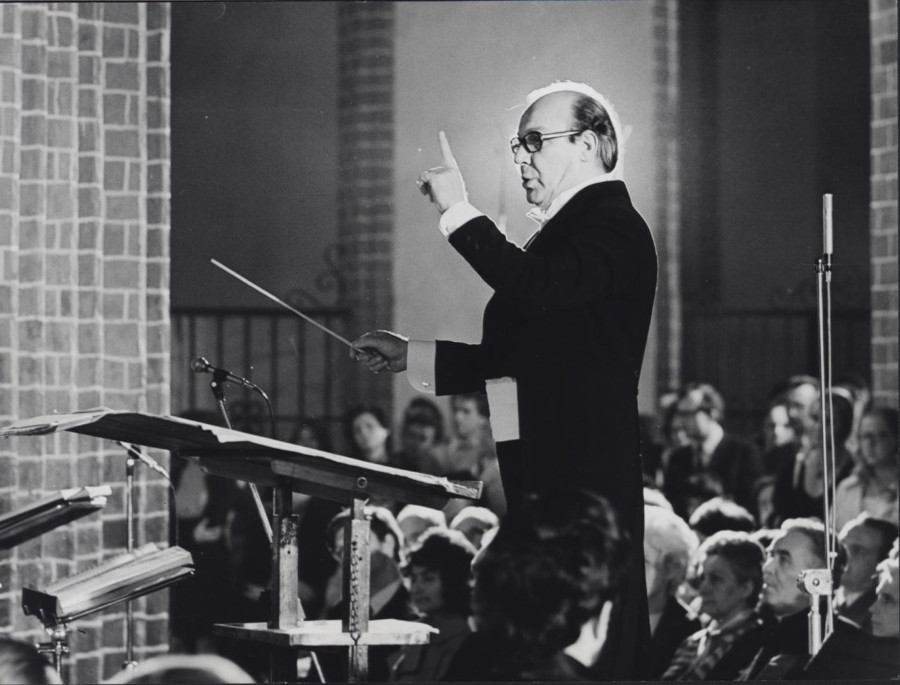The 1960s were like a rollercoaster for the Philharmonic – going up and down. The audience listened to Helena Majdaniec singing about the ruddy saffron milk cap and applauded the brilliant pianist Svetoslav Richter.
The authorities ordered to attract working people from towns and villages to the concerts. Preferably big masses of the people, therefore the Ministry of Culture recommended that the repertoire be corrected; it was supposed to be light, easy and fun. Artistic Director and Conductor of the Philharmonic, Radomir Reszke (he took the helm in 1961 and lasted two seasons), paid a political tribute, but did not forget about real music lovers. It was during his tenure that the Philharmonic, together with the local division of the Polish Composers’ Union, organized the Music Festival of Composers of West Territories, transformed in 1964 into the national Festival of Polish Contemporary Music (Musica Polonica Nova since 1988).
Reszke’s successor, Włodzimierz Ormicki, increased the presence of the (very) popular culture even more. That was rather contrary to wider tendencies as the 1960s initiated the excellent, international fame of Polish classical music. Krzysztof Penderecki, Wojciech Kilar and Henryk Mikołaj Górecki began their international careers by presenting their works as part of the “Warsaw Autumn”, and citizens of Warsaw applauded Igor Stravinsky, Artur Rubinstein and Mstislav Rostropovich at the Warsaw Philharmonic, whereas “Polish youth sang Polish popular songs” at the Philharmonic in Wrocław.
Fortunately, great artists came too, including the brilliant Russian pianist Svetoslav Richter. He stood – next to Rubinstein, Horowitz and Benedetti Michelangeli – among the greatest living pianists in the world. He has conquered Europe and America, reviewers wrote that he “creates a performance of all time”. He had an enormous repertoire. He played everything and was a master of interpretation. It was difficult to bring him to guest appear as he hated the performances to be planned for years ahead. Besides, when he was offended, even God’s intervention could not help. When he was giving concerts at La Scala and going for the next encore, the man who pulled the curtain tellingly looked at his watch that it was time to finish. And then, for twelve years, La Scala management knelt in front of Richter, waiting for forgiveness.
Richter was not the only star saving the reputation of the Wrocław Philharmonic, which had been declining since the early 1960s. The Hungarian pianist Annie Fischer, who was admired by Richter, captivated by her true artistic greatness, and Argentinian Martha Argerich, winner of the 1965 Chopin Competition, aroused just as intense emotions.
But better times came only with Andrzej Markowski, an outstanding conductor and composer (also of popular music, he is the author of, among others, the soundtrack to Pan Wołodyjowski), who in 1965 took over as Director of the Philharmonic. It took three seasons for him to complete a complete turnaround. He strengthened the orchestra by attracting outstanding instrumentalists (Wrocław authorities granted them apartments, so the lure was big), expanded the repertoire, introduced catchy series – Concerts of Concertos and Conducting Recitals. Besides, he moved the Philharmonic to a new, and finally its own, building.
It was created as a result of the redevelopment of the common room of Municipal Building Company, donated to the Philharmonic. The adaptation project was carried out by Wiktor Jackiewicz, the construction works were undertaken by the public donors and in 1968 the Philharmonic got its own concert hall with 500 seats. The whole thing looked good, experts emphasized the functionality of this architecture, especially in terms of interior design, and the economy of means of expression. The musicians were satisfied, and maestro Markowski finally had a place to honour music lovers with dignity. And he fought for them with commitment.
Wrocław did not live by music alone, the decade of television began. There were long queues in front of electronics stores. Demand exceeded supply. In the fall of 1961, the press wrote: “We already have 55,000 TV sets in Lower Silesia”, six years later there were 171 TV sets per 1,000 inhabitants of Wrocław. In 1962 in Wrocław, in the building of the Polish Radio, a television studio was established, from which local programmes were broadcast. Thus the inhabitants of Wrocław watched familiar faces and streets on a glass screen. But soon they were also going to see musicians, because Andrzej Markowski created a hit festival, which first attracted the attention of the whole of Poland, and then of Europe.
Wratislavia Cantans was born in August 1966 as the Oratorio and Cantata Festival. Its first edition was modest. It began with a concert in the studio of the Polish Radio Broadcasting Station. The cperformers guaranteed the level; performed by the Warsaw Philharmonic Choir, the Polish Radio Orchestra and Choir in Kraków, Wrocław Philharmonic, a group of outstanding soloists (Halina Łukomska, Krystyna Szostek-Radkowa, Krystyna Szczepańska). Markowski introduced music to historic interiors, concerts were held in the Aula Leopoldina, St Elizabeth church, at the Museum of Architecture, in the Magdalen parish. The audience stormed these extraordinary venues, the more so as Wratislavia attracted great fame. The roller coaster moved up.
Beata Maciejewska

